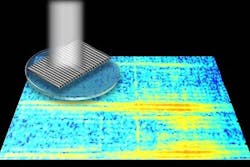New super-resolution imaging technique is low-cost for universities
By combining a diffraction grating (a special, finely ruled plate shown at upper left) with a conventional optical microscope, scientists are able to dramatically increase the microscope’s resolution to below the wavelength of light.
A team of researchers from the University of Massachusetts Lowell (UMass Lowell) and King's College London (England) has demonstrated a new, low-cost way to capture super-resolution images of biological structures such as viruses and nanoparticles.
Related: New twists on superlenses improve subwavelength microscopy
Called interscale mixing microscopy (IMM), the technique can obtain details in these structures much smaller than the wavelength of light (known as the diffraction limit)—so it could be useful in developing new vaccines against pathogens and novel pharmaceutical drugs to fight diseases. Prof. Viktor Podolskiy, the principal investigator for the UMass Lowell team, explains that when an object is smaller than the wavelength of light, you cannot resolve the object's size, shape, or structure—the team's technique, however, is designed to go beyond the diffraction limit.
"Subwavelength imaging with IMM can potentially be used to obtain the colors, or spectra, of small objects such as bacteria, viruses, and nanoparticles," Podolskiy explains. "By knowing their color signatures, we can rapidly identify and characterize the objects and determine their precise chemical composition."
The IMM technique uses a conventional optical microscope and ingenious signal processing to decode the object's properties based on the measurement of light that gets scattered by the object in close proximity to a special, finely ruled plate called a diffraction grating. The researchers showed that a single measurement with the grating may be enough to decipher with great precision the position, size, and optical spectrum of the object.
Scanning electron microscopes (SEMs) can typically resolve details down to 5-10 nm. Right now, the IMM is constrained to about 70 nm. "Although our technique is not yet as powerful, a brand-new scanning electron microscope can cost anywhere from hundreds of thousands of dollars to a million," says Christopher Roberts, a PhD student in physics who conducted the project's data processing and analysis. But the research team's IMM, he says, can be retrofitted to older, existing research optical microscopes, thereby saving universities and companies a lot of money.
Also, SEMs are unable to observe living cells, but the IMM could be used to observe live specimens in real time. "Our technique could pave the way for the next generation of optical microscopy and nanoscale spectroscopy," Roberts says.
Full details of the work appear in the journal Optica; for more information, please visit http://dx.doi.org/10.1364/optica.3.000803.
